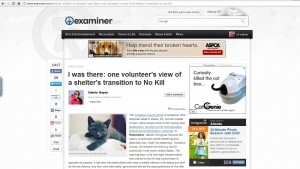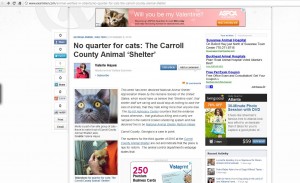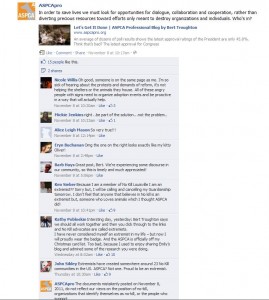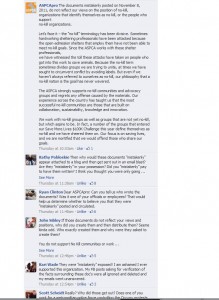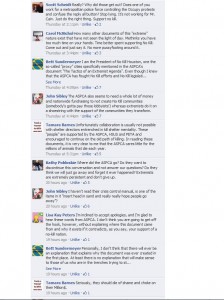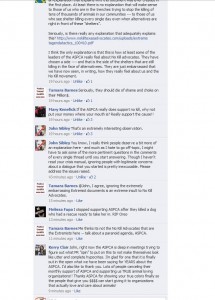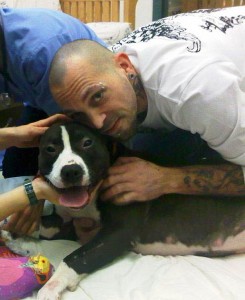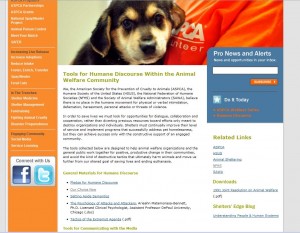A reply to my open letter to Mary Jo White, Chair of the ASPCA Board of Directors

Ernest says, "If the ASPCA wants to be my voice, they're going to have to do a hell of a lot better than this."
Early last Thursday morning, I published an open letter to Mary Jo White, Chair of the ASPCA Board of Directors, and emailed a copy to her at her law office. Earlier this afternoon (its Tuesday), I received a reply, not from her, but from the ASPCA Public Information Office.
A form letter. How rude. How disappointing. How unsurprising. How typical.
I would like to note that although in my original letter, I had specifically requested that my intelligence not be insulted, they went ahead and did it anyway. Notably absent from this form letter are any links to the full text of the Amy Paulin/ASPCA Quick Kill Bill (the A5449 that the ASPCA is touting below) or to the Kellner CAARA Bill. That is because anyone of normal intelligence would be able to see that the ASPCA’s bill is comprised of nothing but loopholes allowing the continuation of the status quo, while the Kellner bill would result in genuine reform.
The letter appears to assume that the recipient is some sort of babe in the woods–utterly uninformed and lacking in even the most basic critical thinking skills. Perhaps this is who the ASPCA’s Public Information Office is accustomed to writing for–the superficial check-writer who will believe anything she is told as long as it contributes to her desired self-image as an animal-lover. That ain’t me, as I explained pretty clearly in the letter that got this rot for a reply:
Dear Friend of Animals:
Thank you so much for your interest in the ASPCA. The ASPCA has always encouraged open dialogue and the thoughtful exchange of ideas, and I appreciate your contacting us with your concerns regarding the shelter access legislation in New York. There is a lot of information circulating on this bill so allow me to explain what it does and does not do.
The ASPCA applauds efforts to foster cooperation and to save lives through shelter-rescue partnerships. We support shelter access legislation crafted to accomplish the twin goals of saving lives and preventing suffering caused by hoarding, cruelty and neglect, and animal fighting. We think that A. 5449-A and S. 5433-A strike a good balance by instituting some positive procedures to help lost pets find their way home, enhancing shelter care for animals, fostering collaboration between shelters and rescue organizations, and ensuring that animals are not placed in harm’s way by incorporating necessary safeguards to prevent animal suffering.
Here are some of the advances A. 5449-A and S. 5433-A make that will save lives:
1) Establishes new procedures to help ensure that lost animals are reunited with their owners;
2) Requires appropriate vaccinations and emergency care to prevent pain and suffering for animals brought into shelters;
3) Prevents euthanasia if an appropriate rescue option is available;
4) Requires every shelter to establish a list of rescues to notify prior to euthanasia to ensure that as many animals are provided rescue as possible;
5) Strikes current law allowing euthanasia if an animal is “unfit for any useful purpose” and instead requires that the animal be suffering incurably; and
6) Includes safeguards that would help prevent animal fighters or hoarders from being able to pose as a rescue organization, thereby avoiding sending animals to situations that would experience intense suffering and death.
Criticisms of this legislation have been generated by individuals who support a different, competing bill that would require that shelters hand over animals to organizations without the shelter having authority to inspect the facility where animals are taken to ensure their health and well-being. While we support the broader goal of saving as many lives as possible, we believe it must be done with protections that ensure animals are not put at risk and placed in situations where they will experience tremendous suffering. That is why we have determined that A. 5449-A and S. 5433-A is the best way to instigate cooperation and rescue work without jeopardizing our homeless and lost animals. There has been confusion regarding some of the language in this bill and we are actively working with Assemblywoman Paulin to make amendments.
If you have any further questions or concerns, please feel free to contact me again. Thank you for being an animal welfare advocate and for all you do to help.
Sincerely,
ASPCA Public Information
The information contained in this e-mail, and any attachments hereto, is from The American Society for the Prevention of Cruelty to Animals® (ASPCA®) and is intended only for use by the addressee(s) named herein and may contain legally privileged and/or confidential information. If you are not the intended recipient of this e-mail, you are hereby notified that any dissemination, distribution, copying or use of the contents of this e-mail, and any attachments hereto, is strictly prohibited. If you have received this e-mail in error, please immediately notify me by reply email and permanently delete the original and any copy of this e-mail and any printout thereof.
I’ll plod through it paragraph by paragraph. Care to guess how many lies I’ll find?
Paragraph 1: The ASPCA does NOT encourage discussion or the open exchange of ideas. They block anyone on their Facebook page who questions or criticizes them. They call shelter reform advocates ‘extremists’ and work both publicly and clandestinely to fight desperately-needed reforms. They have yet to engage in any meaningful discussion with anyone on the issues of Oreo or rescue access or the deplorable state of NYCACC or any of a host of other issues. I do get a kick out of the “There is a lot of information circulating on this bill so allow me to explain what it does and does not do” line. A lot of information. And just who is ‘me’? This form letter is not signed with a person’s name. Will no one at the ASPCA take responsibility for the Quick Kill Bill or even this stupid little pack of lies form letter?
Paragraph 2: The folks in Austin had to fight the ASPCA tooth and nail for the reforms needed there. I don’t think that what the A tried to do while Fix Austin and Austin Pets Alive! were trying to save animals and reform the shelter would be characterized by them as “applause” nor would they be likely to call it “fostering cooperation.” As if that weren’t enough, they trot out the “rescuers are hoarders and dog fighters in disguise” argument, because lobbing baseless insults at rescuers is such a good way to promote cooperation and lifesaving. Everyone just loves it when you insinuate that they are mentally ill or criminals. The Quick Kill bill does not “strike a good balance” (love that phrase!) between anything. It leaves all of the power in the hands of those who have shown themselves least able to use it responsibly–the shelters that kill as a means of population control. It grants none to those who would take responsibility for saving lives, those who would speak out about the abusive conditions they witness when visiting shelters to pull animals–the rescues. Then there’s the hidden subtext–why do we need shelter reform and shelter access legislation now? Where has the ASPCA been all these years? Shouldn’t the mighty A have demanded years ago that shelters be true to the name, that they save lives, work with rescuers, and refrain from abusing the animals in their care? The ASPCA is reacting to something, not leading.
Paragraph 3: The ASPCA bill does none of the things listed. If anything, it does just the opposite. That is why numerous animal advocates have characterized it as dangerous. The points advocates have found most objectionable are those that allow animals deemed to be in “psychological pain” to be killed immediately, and rescues to be excluded from a shelter’s list of approved rescues for arbitrary reasons. This would allow frightened and lost family pets to be killed before their families could possibly get to the shelter to reclaim them. Points 5 and 6 are perhaps the most egregious lies on the list, as the bill does not require that an animal be suffering incurably to warrant euthanasia, and it is not aimed at keeping animals out of the hands of abusers, but would allow shelters to retaliate against rescues that speak out against abuses they witness at the shelter by excluding them from rescuing, thereby keeping them out of the hands of people with a conscience.
Paragraph 4: Actually criticisms of the Quick Kill Bill have “been generated” by a great many individuals and organizations. Furthermore, we support CAARA, which is not a “competing bill,” but the original bill in this scenario. The Quick Kill Bill was put together by the ASPCA to compete with it, not the other way around as they are trying to imply. Furthermore, CAARA spells out specific, standardized, and meaningful requirements for rescues, and it does not require shelters to just hand animals over to just anyone. They go on to qualify support for saving as many lives as possible, a classic “yes, but” statement. Whenever someone consistently makes “yes, but” statements, particularly when they make the same ones over and over despite having the “but” part of the statement addressed or refuted, I am forced to conclude that they do not really want change, at least not this change. What do they really want? They want us to shut up and go away, but keep those checks coming.
And “instigate cooperation and rescue work”? I have to see that as a Freudian slip. The word “instigate” is generally used in reference to getting negative things started–riots, strife, stuff like that. So the A really sees cooperation and rescue work as negatives. That explains a few things.
As for the alleged “confusion” about this bill, that “confusion” is not on the part of its critics. We’re critics of it because we care about animals and we can read. And Assemblywoman Paulin did not cook up her bill by herself. It was written by and for the ASPCA. Please do not persist in insulting advocates’ intelligence like this. It makes me testy.
Paragraph 5: Contact who, precisely? And why? Do you have other form letters I might want to add to my collection? And what do you think you’re thanking me for?
Signature: “ASPCA Public Information,” I doubt that is what your mother calls you, just as I doubt your sincerity and that of the Chair of your Board of Directors, and that of your CEO.
So, Mary Jo White got my email but failed to get its message. Rather than take responsibility for replying herself, she passed it along and “ASPCA Public Information” got my email but failed to get its message. To both of them I say: You cannot choose to hear only the ‘ka-ching!’ of money rolling in, the sound generated by all of those sad-eyed puppy ads, that self-reflective sound you yourselves have orchestrated, that fun-house mirror you hold up to ask “who is most humane of them all?” To both of them I say: The sounds of checkbooks slamming shut, of people demanding real change, of people making real change happen, these sounds are growing louder every day.
Listen to them, even if it is only out of enlightened self-interest.


